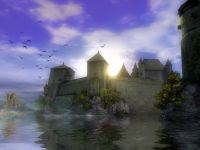| |
Site Navigation
Main
News
Forums
Games
Games Database
Top 100
Release List
Support Files
Features
Reviews
Previews
Interviews
Editorials
Diaries
Misc
Download
Gallery
Music
Screenshots
Videos
Miscellaneous
Staff Members
Privacy Statement
|
|
There is a Glympse interview at HomeLan today. They talk to Sojourn's Jason Yarnell, Glympse's game designer, Dave Cerra, Glympse's creative director, and Chris Miller, Glympse's programming lead about the game:
HomeLAN - How "big" will the world of Glympse be for players in the game and what sorts of locations and settings will they be able to explore?
Dave Cerra - Saying the world is "big" is somewhat of a misnomer. It's really hard to get across the scale of the planet. You have to see it to really understand (patience, patience). We're currently designing a spherical planet that's a little bit smaller than Mars – approximately 13,000 kilometers in radius. That's about half of the size of earth. Cael, the first planet that will be populated in the universe of Glympse, is very similar to earth in that you'll find deserts, forests, grassy plains, mountains and foothills, valleys – if you see it on earth, you'll see it on Cael. We're also building many features that are unique to Cael to push game play into interesting areas.
Chris Miller - Just to try and put it into perspective, the first terrain test we did featured a landmass of 800km by 800km (640,000km total – just shy of the state of Texas). With a land mass this expansive, we run into a few unique problems, and that is creating content for such a large area. Our mappers however, also have the added advantage of not having to be constrained to the size of their locations, so they can really go hog wild with their design, creating vast locations as opposed to more self-contained and centralized ones. For example, lets take a dungeon. The mapping and level design team go ahead and build the dungeon and all its nifty nooks and crannies but they can also create a location around the dungeon, say, rocky crags with horrible lava flows and erupting volcanic areas. They can tool the environment to coincide with their location vision. |
|
|





 Glympse Interview at HomeLan
Glympse Interview at HomeLan